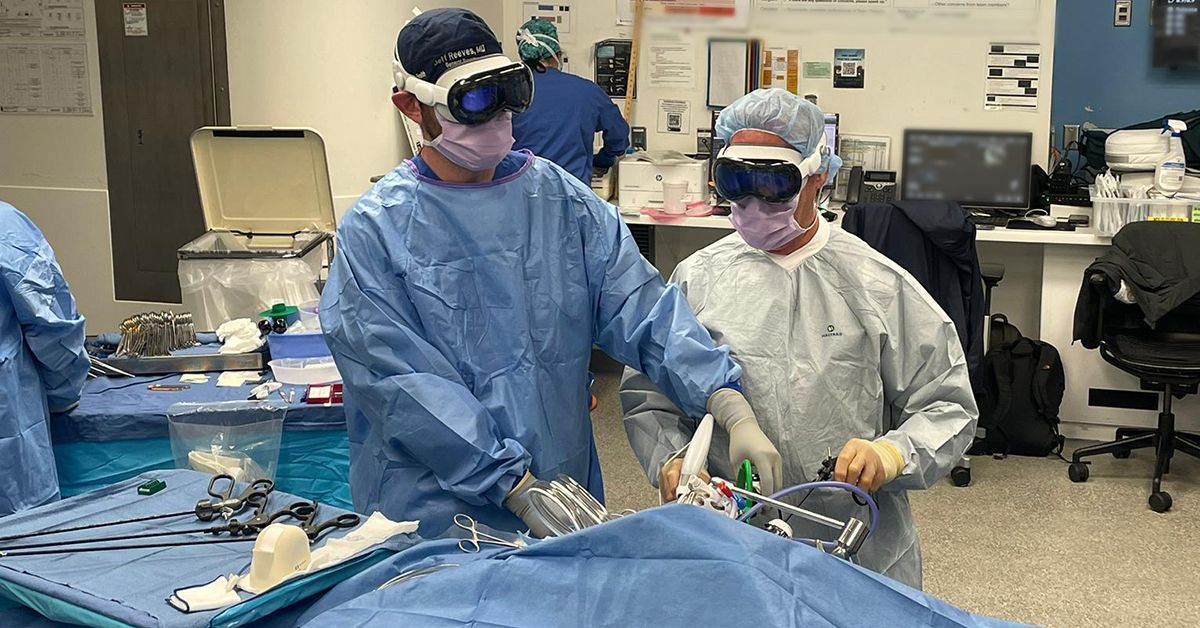Clinical Trial Evaluates Spatial Computing App on Apple Vision Pro in Operating Room
UC San Diego Health is the first in the nation to test potential use of apps on Apple Vision Pro in surgical environment
Story by:
Published Date
Article Content
Minimally invasive surgeons at UC San Diego Health are the first in the nation to evaluate the potential use of spatial computing apps on Apple Vision Pro in the operating room. This feasibility study was initiated after two months of testing in the Center for the Future of Surgery at the University of California San Diego School of Medicine.
“As surgeons, we are always looking for technologies that can help us deliver more safe and precise surgeries for our patients,” said Santiago Horgan, MD, chief of minimally invasive surgery at UC San Diego Health and director of the Center for the Future of Surgery. “The experience of the surgeon in the operating room, while interacting with imaging, is critical to patient outcomes.”
“This study is investigating whether spatial computing technology can enhance the surgical experience. Using an app that can stream a video feed from other devices, Apple Vision Pro can display the patient’s medical imaging, vital signs and the surgical camera view in real-time to guide decision making while the surgeon operates in a more ergonomic position,” said Horgan. “We are exploring whether this technology could revolutionize the operating room environment to benefit patients and doctors.”
Patients consented to the use of the technology prior to the procedure. All surgeries were performed under the guidance of the Institutional Review Board, which ensures the safe treatment of research volunteers.
The current trial is evaluating this use for ergonomic and clinical capabilities. During the study, surgeons using Apple Vision Pro also have access to a simultaneous set-up of traditional operating room monitors and displays.
Surgeons may stand in a surgery for anywhere from 30 minutes to more than 12 hours, depending on the complexity of the procedure. The length of the surgery and concurrent use of multiple technologies mounted from floor and ceiling can take a negative toll on the surgeon’s body, especially the neck and shoulders.
“Published studies show that minimally invasive surgeons experience musculoskeletal pain at higher rates due to continuous use of multiple imaging systems,” said Ryan Broderick, MD, principal investigator and minimally invasive surgeon at UC San Diego Health. “More technology platforms in surgery often means that the physical space in the operating room is crowded. A spatial computing platform, however, allows for infinite digital space to display imaging and potentially an overall streamlined workflow.”
"With the successful completion of the first surgery using an app on Apple Vision Pro, we may identify new applications in health care technology,” said Christopher Longhurst, MD, executive director, executive director, Joan and Irwin Jacobs Center for Health Innovation, and chief clinical and innovation officer, UC San Diego Health. “The knowledge learned will potentially enhance the surgical experience and pave the way for transformative advancements in medical practice."
Launched in 2021, the Jacobs Center for Health Innovation is dedicated to advancing digital health solutions, including wearables, apps, and leading-edge AI-driven health service models. The center’s mission is to enhance access to data, facilitate better communication between patients and health care providers, and empower individuals to make informed decisions about their health.
You May Also Like
UC San Diego is Strengthening U.S. Semiconductor Innovation and Workforce Development
Technology & EngineeringStay in the Know
Keep up with all the latest from UC San Diego. Subscribe to the newsletter today.




